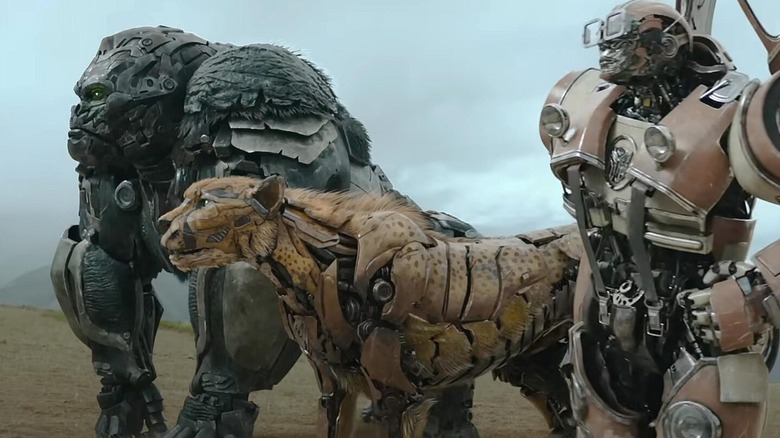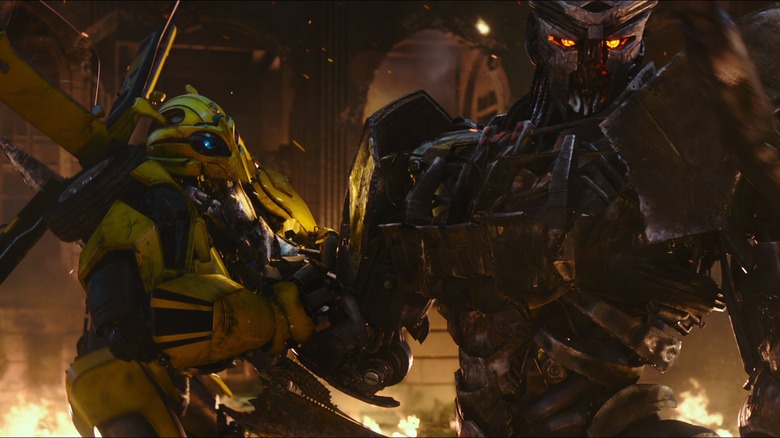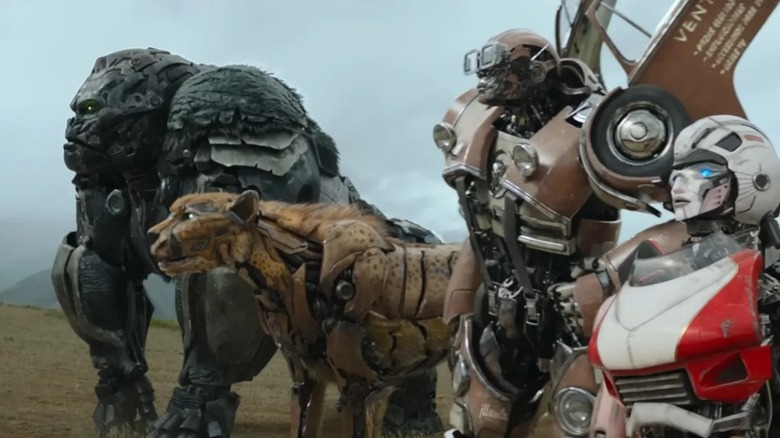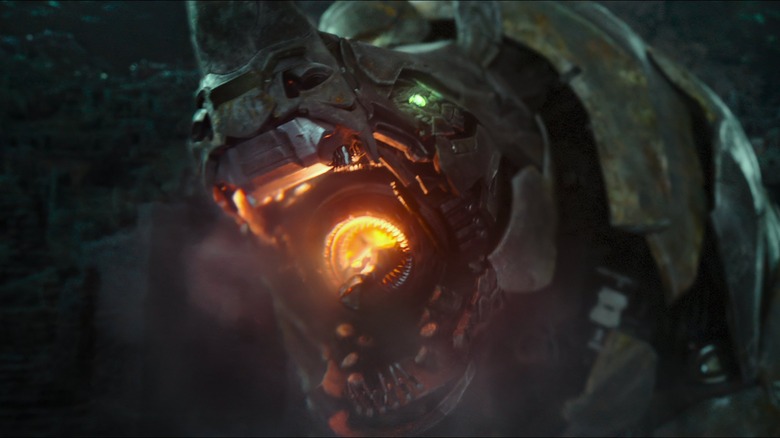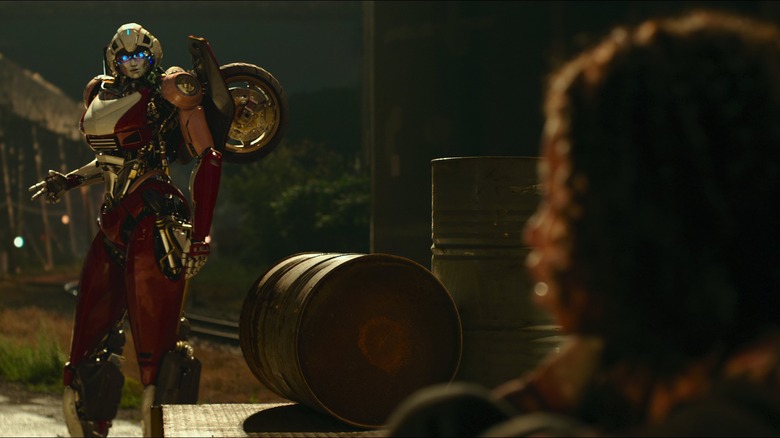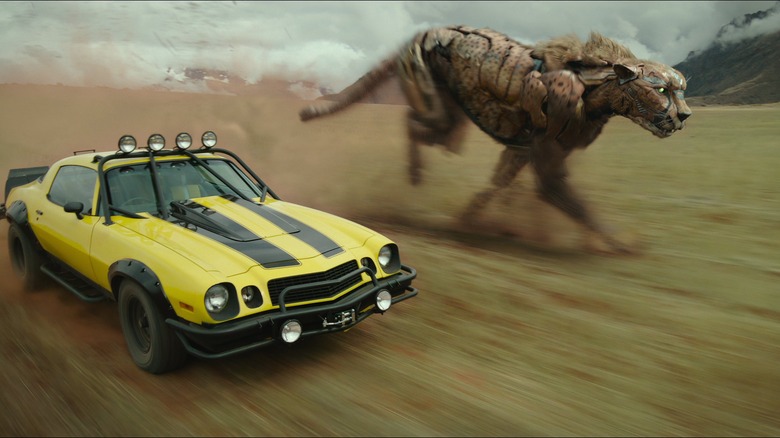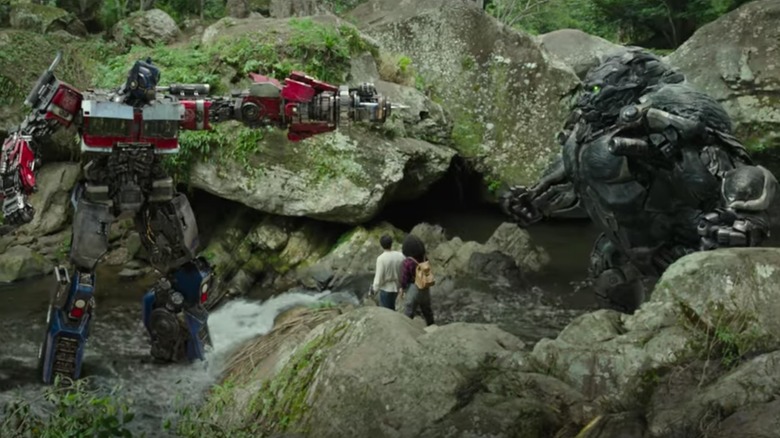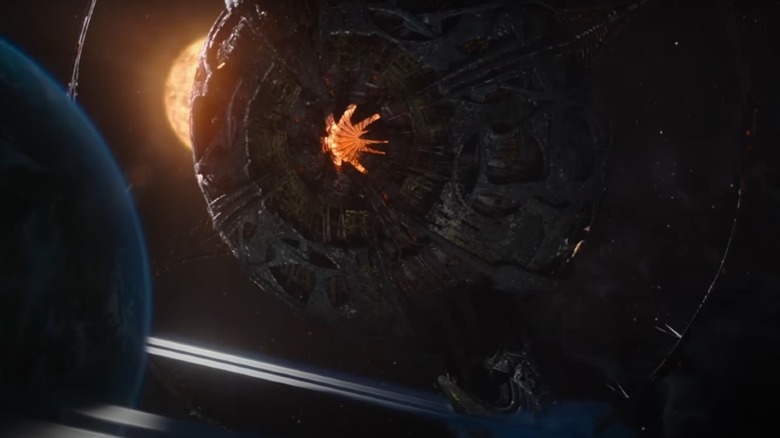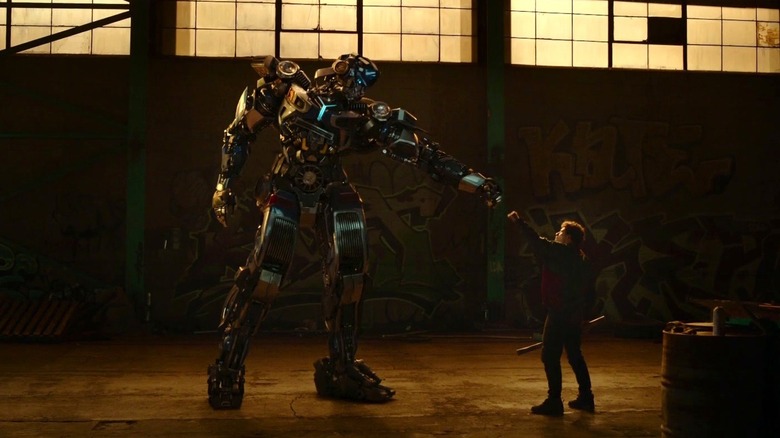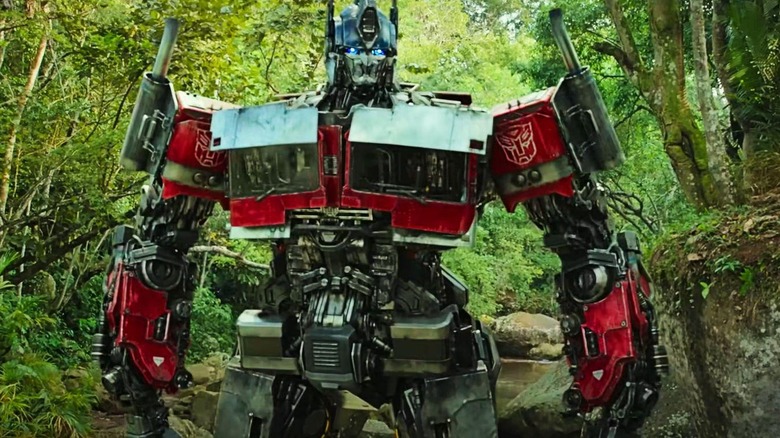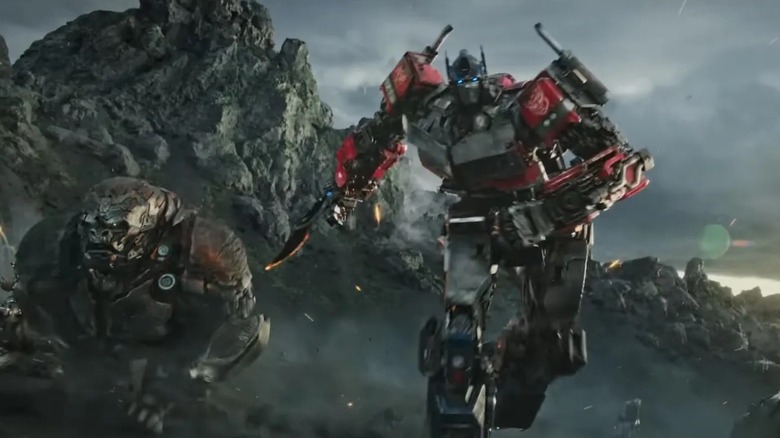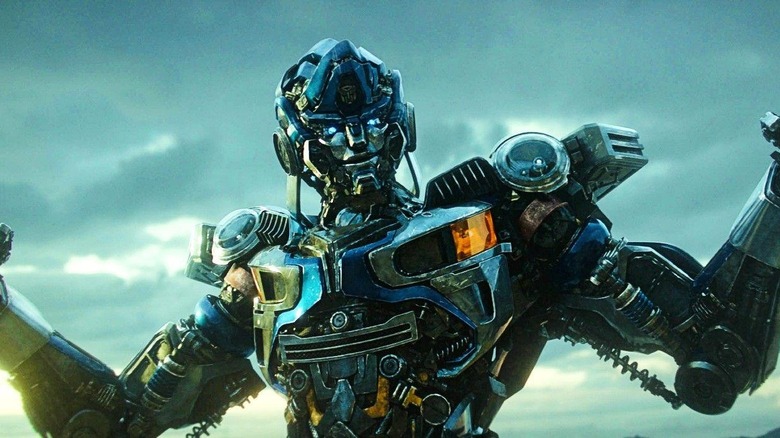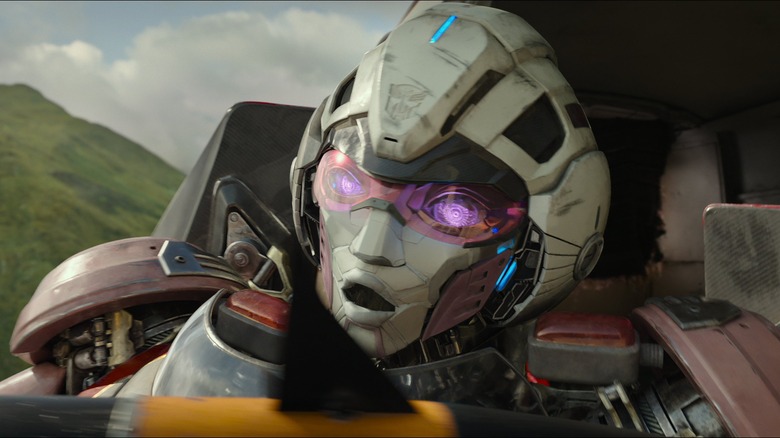The Ending Of Transformers: Rise Of The Beasts Explained
Contains spoilers for "Transformers: Rise of the Beasts."
Every "Transformers" movie ends with a whiz-bang fireworks show hinging on robots beating the ever-loving tar out of each other. Even the more low-key 2018 installment "Bumblebee" couldn't resist having its titular lead square off against a pair of Decepticons in its climax. Typically, these endings have been dominated by the kind of chaotic mayhem only director Michael Bay can deliver, for good and for ill. "Transformers: Rise of the Beasts" is only the second live-action "Transformers" movie to not be helmed by the auteur behind "Armageddon" and "Ambulance." However, "Rise of the Beasts" filmmaker Steven Caple Jr. is still willing to emulate the scope and action-heavy sensibilities of Bay's works when it comes to crafting the ending of this newest "Transformers" movie.
Given all the noise and pummeling that occurs, it can be easy to lose track of seemingly important things at the end of "Transformers: Rise of the Beasts," including just where those titular robotic animals went when all the fighting was done. This breakdown of the ending of "Transformers: Rise of the Beasts" aims to provide any clarity over what just happened in this summer blockbuster's conclusion, as well as shed light on what this feature's ending could mean for the future of the "Transformers" movie franchise. As this exploration will make apparent, the ending of "Rise of the Beasts," like the home stretch of any "Transformers" movie, sends audiences out of the theater with an overwhelming amount of material and spectacle.
What is the big ending of Transformers: Rise of the Beasts?
The climactic battle of "Transformers: Rise of the Beasts" is triggered by the villainous Scourge (Peter Dinklage) uniting the two pieces of the movie's main MacGuffin, which allows the nefarious planet-consuming Unicron (Colman Domingo) to make his way to Earth. With only a small window of time to save this planet, the Autobots, robotic animals known as the Maximals, and a pair of humans, Noah (Anthony Ramos) and Elena (Dominique Fishback), all join forces to stop Scourge. This showdown, occurring in an isolated part of a Peruvian rainforest, heavily involves Autobots and Maximals duking it out with a bunch of Scourge's mindless minions, an army of robotic scorpions, as well as the baddie's two primary Terrorcon allies, Battletrap (David Sobolov) and Nightbird (Michael Jae Rodriguez).
The drama of this set piece comes not only from the impending arrival of Unicron but the fact that destroying the device that will bring him to Earth also means shattering an object that could bring Optimus Prime (Peter Cullen) and his Autobot brethren back to their home planet of Cybertron. In the end, Prime, after brutally murdering Scourge, makes the ultimate sacrifice to save Earth and its people by destroying Unicron's interdimensional doorway. Afterward, the surviving Autobots, Maximals, and humans all go their separate ways, though the potential for Unicron's return means that a reunion could someday be in the cards.
The more things change, the more they stay the same
In 2018, "Bumblebee" earned rave reviews for taking more cues from "The Iron Giant" than a typical live-action "Transformers" movie. There were fewer robots on-screen in this prequel, no cities were getting blown up, and pathos was given a greater emphasis than endless explosions. "Transformers: Rise of the Beasts" exemplifies its decision to bring the "Transformers" movies closer to the age of "Transformers: Dark of the Moon" with its ending, which focuses almost exclusively on CG characters fighting with one another. Even more than the Bay "Transformers" titles, though, the climax of "Rise of the Beasts" is taking massive cues from the "Avengers" movies. The "surprise" return of a resurrected Bumblebee dropping in from the skies just when all hope seems lost especially echoes key crowd-pleasing moments from the finales of "Avengers: Infinity War" and "Avengers: Endgame."
The greatest flourish "Rise of the Beasts" incorporates to differentiate itself from previous Marvel and "Transformers" movies is to emphasize the importance of Noah in all the chaos. Whereas previous "Transformers" titles had to give human characters like Sam Witwicky or Cade Yeager human baddies to duke it out with while the Autobots fought Megatron, here, Noah gets a mech suit that allows him to fight Scourge side-by-side with the Autobots. It's a unique touch in the pantheon of "Transformers" movie climaxes, but it isn't quite enough to ensure that the finale of "Rise of the Beasts" avoids feeling derivative.
The Rise of the Beasts ending is COVID-19 friendly
One of the more notable differences between the ending of "Rise of the Beasts" and its predecessors is where it takes place. Three of the first four "Transformers" movies featured climactic robot showdowns taking place in heavily-populated cities. Even the finale of "Transformers: The Last Knight," which took place far away from skyscrapers, still involved large armies of human beings. By contrast, "Transformers: Rise of the Beasts" ends with the lead characters fighting to save Earth far away from any heavily-populated areas. Noah and Elena are the only live-action beings in sight, and no recognizable landmarks get destroyed by the impending presence of Unicron.
Setting the finale of "Rise of the Beasts" in a more isolated area was likely a conscious decision to help the feature stand on its own two feet compared to earlier "Transformers" movies, not to mention minimize the kind of collateral damage that troubled audiences in movies like "Man of Steel." However, it's also worth noting that "Rise of the Beasts" began shooting in June 2021, just 15 months after the COVID-19 pandemic first shut down the American film industry. It's highly likely that this ending was willed into being in part because of how it could be shot under COVID-19 safety protocols, particularly in how it would use only a pair of flesh-and-blood actors and would be set entirely outdoors.
The introduction of Exosuits into the Transformers movies
While occasionally humans in the "Transformers" have been able to temporarily utilize Cybertronian weaponry to fight back against Decepticons, for the most part, these characters have to leave the robot skirmishes to Optimus Prime and company. These humans are just so often overwhelmed by the forces of characters like Megatron and Starscream that it seems comical to imagine them being able to fight back. However, earlier "Transformers" media offered up a solution for how human beings could fight alongside robotic warriors. The 1986 feature "The Transformers: The Movie" is one of the most popular early depictions of an Exosuit in "Transformers" lore. The Exosuit is a robotic armor human beings can wear that allows them to keep up with Autobots and Decepticons in the heat of battle.
This concept comes to the live-action "Transformers" movies for the first time at the ending of "Transformers: Rise of the Beasts." A seemingly dying Mirage (Pete Davidson) uses some of his own parts to give his pal Noah an Exosuit that the human can use to help defeat Scourge. Looking like one of Iron Man's armors decked out in silver with hints of blue, the "Rise of the Beasts" Exosuit allows Noah to take on a slightly more active role in the action-packed ending of a "Transformers" movie compared to past human protagonists. It also allows further vintage "Transformers" lore to live on in "Rise of the Beasts" as a source of potential crowd-pleasing moments.
'Til All Are One: The emphasis of unity in the ending of Rise of the Beast
"'Til all are one." It's a phrase uttered by Optimus Prime in his final moments before dying in "Transformers: The Movie" in 1986. Since then, it's become a fixture of the franchise, with various incarnations of Optimus Prime and other "Transformers" characters uttering it in a slew of different contexts. It becomes a core phrase in the final half-hour of "Transformers: Rise of the Beasts," especially as it pertains to characters like Optimus Prime and Noah growing more accustomed to working with others. Their initial hesitations at the idea of human/Autobot cooperation are eliminated once Unicron begins to descend on Earth. With the apocalypse bearing down on them, Optimus Prime's "'til all are one" phrase becomes a rallying cry for a variety of robots and humans to work together for a greater goal.
"Transformers: Rise of the Beasts" uses this classic "Transformers" phrase to inform its primary theme emphasizing the importance of unity, though its ending winds up undercutting this concept. Poor Elena, for instance, is sidelined for much of the climax, while characters native to Peru are only fleetingly seen and often inhabit uncomfortable stereotypes of the "stoic" indigenous people. It's admirable that "Transformers: Rise of the Beasts" wants to trade the cynicism of the Michael Bay "Transformers" movies for something hopeful, but the flaws in its screenwriting hinder these ambitions and the core ideas behind the phrase "”til all are one."
What happens to the Maximals?
"Transformers: Rise of the Beasts" kicks off its runtime with a prologue depicting a quartet of Maximals escaping their home planet. This scene even makes room to show the original Maximals leader Apelinq (David Sobolov) being murdered at the hands of Scourge. It's a lengthy sequence establishing the idea to moviegoers that these characters will be critical to everything that will transpire in "Rise of the Beasts." Unfortunately for "Beast Wars" fans everywhere, the Maximals take forever to return to the movie, though at least they factor heavily into the plot once they do show up again. Naturally, these characters do play a noticeable role in the finale, with Optimus Primal even managing to save the lives of Optimus Prime and Noah in an especially tense moment.
The weirdly subdued presence of the Maximals in the core plot of "Rise of the Beasts" even extends to the final time audiences see these characters. The Maximals are last shown remaining in their Earth home of the Peruvian rainforest, with Optimus Primal pounding his chest on a cliff as the Autobots fly away. Though the story began through the eyes of these characters as they narrowly avoided Unicron's horrors, "Rise of the Beasts" just breezes past the Maximals in its ending. The lack of concrete resolution regarding Optimus Primal and pals would be a strange detail in any context, but it's especially strange given how "Rise of the Beasts" initially seems deeply committed to these automatons.
What happens to Unicron?
While Optimus Prime manages to make a bold sacrifice to keep Unicron away from Earth, the ending of "Transformers: Rise of the Beasts" makes it clear that the villain isn't finished with his evil machinations. Optimus Primal explicitly states that while Unicron is temporarily thwarted, there's no way he's dead. Audiences don't get to explicitly see where Unicron is hiding out now, but Optimus Primal's word is good enough to know he's still out there. Given that Paramount Pictures is hoping that "Transformers: Rise of the Beasts" kicks off a new trilogy of "Transformers" movies, it wouldn't be shocking for Unicron to function as the overarching antagonist of this new era of "Transformers" cinema.
The resolution to Unicron's presence in "Rise of the Beasts" doesn't, however, offer any clarity to how his role in this movie reconciles with the previous depiction of Unicron in the live-action "Transformers" movies. The 2017 installment "Transformers: The Last Knight" explicitly revealed that the planet Earth is actually Unicron, who's been dormant for eons but begins to rise again in the film's climax. Given that comments from the "Rise of the Beasts" creative team indicate this new movie is still meant to be in continuity with earlier live-action "Transformers" fare, it's peculiar the wrap-up to Unicron's plotline doesn't offer any clarity for how two wildly different versions of this planet-gobbling baddie can exist in the same franchise.
Where do the human leads of Rise of the Beasts go?
While there's uncertainty about where the Maximals and Unicron go next in the ending of "Transformers: Rise of the Beasts," the blockbuster is much more clear about the fates of its two human protagonists. Noah, for one, heads back to his apartment after saving the world, giving his mom and younger brother a big hug. Though he's now fought alongside robots, family is clearly as important as ever for Noah, and the final moments of "Rise of the Beasts" even focus on him going in for a job interview so he can chip in around the house. While waiting for that interview, Noah spies something on a nearby TV that offers a resolution for Elena's plotline.
On this TV, Noah witnesses a commercial for a forthcoming "60 Minutes" interview with Elena, who has become a famous archeologist based on her discoveries in Peru. Her work previously helped the Autobots save the world, and now she finally has the chance to be seen as a titan in her profession. She's come a long way from the earliest scenes in "Rise of the Beasts," where she was just an intern at a museum struggling to get the attention of her superiors. In the wake of their first adventure with robotic lifeforms, both Noah and Elena, judging by the ending of "Transformers: Rise of the Beasts," have managed to carve out truly satisfying lives.
The twist on the famous Transformers ending narration
Save for "Bumblebee," each of the live-action "Transformers" movies has ended similarly. In voice-over narration, Optimus Prime gives a commanding speech directed at any Autobots hiding out among the stars. This collection of words tends to encapsulate the themes of the preceding movie and offer some hope for the future even after the tremendous losses incurred in a battle with the forces of evil. "Transformers: Rise of the Beasts" offers up a bit of a tweak to this formula, though not at the expense of a new Optimus Prime speech. Like the first five "Transformers" movies, voice actor Peter Cullen belts out a big monologue as Optimus Prime ... but this time he's not the only one delivering a speech.
Once Prime's words are finished, Noah begins to deliver his own final speech through narration. Set to footage of him returning home to his family, Noah notes that he's just a simple guy from New York, but that he's willing to do anything, even save the world with the Autobots, to protect his family. It's a noticeable shift that cements Noah as the new face of the franchise going forward, while also displaying a balance between the past of the "Transformers" movies and new flourishes. If this saga wants to continue as a major part of the blockbuster movie landscape, that means subverting expectations, even when it comes to "Transformers" staples like Optimus Prime's closing speech.
That ending teasing a Hasbro Cinematic Universe
The final pre-credits scene of "Transformers: Rise of the Beasts" ends with Noah going in for a job interview with a seemingly ordinary businessman (played by Michael Kelly). However, that man quickly reveals that he knows about the Autobots and how Noah has saved the world. This guy and his references to working for a larger organization initially make it appear that he's someone from Sector Seven, the secret agency from "Transformers" and "Bumblebee." However, a business card from the mysterious stranger reveals the real organization Noah has come into contact with: G.I. Joe.
Yes, "Transformers: Rise of the Beasts" doesn't wait until its credits to tee up not just sequels, but a big cinematic universe fixated on Hasbro properties like "Transformers" and "G.I. Joe." This tease is confounding rather than exhilarating on several levels, not least of all that there currently isn't an ongoing series of "G.I. Joe" movies.It's unclear what a union between these two adaptations would even look like, and the brief glimpses of a shabby-looking base belonging to this universe's version of G.I. Joe doesn't inspire much confidence for the visual possibilities of a crossover. Still, the ending of "Transformers: Rise of the Beasts" makes it apparent that the future of the Autobots on the big screen will involve working with at least the "G.I. Joe" universe and almost certainly other further Hasbro properties.
That mid-credits scene
The arrangement of the big set-up scenes at the end of "Transformers: Rise of the Beasts" is quite peculiar. The massive sequence revealing that G.I. Joe exists in the same universe as the Autobots is such a sizable revelation that a follow-up scene would have to depict Optimus Prime and Taylor Swift crooning out a cover of "Cruel Summer" to register as equally significant. Unfortunately, the mid-credits scene of "Rise of the Beasts" isn't anything too memorable, and merely hinges on a predictable gag that would've been underwhelming even if it didn't come hot off the heels of a big crossover tease.
This scene depicts Noah introducing his licorice-fixated friend Reek (Tobe Nwigwe) to his new car, a repainted and modified version of Mirage's automobile form. After Reek makes some derogatory comments about how the vehicle isn't anything special, Mirage transforms into his robot form and begins to berate Reek for his opinions. It's clear what the punchline of this comedic scene will be from frame one, while the overabundance of Davidson's comedic schtick in the rest of "Rise of the Beasts" makes it unlikely any moviegoers were clamoring for even more of the character. This mid-credits "Rise of the Beasts" sequence would've been better served coming before the big G.I. Joe tease, but truth be told, there was no place within the movie that would've made this scene instantly hysterical.
Where does the Transformers franchise go from here?
The ending of "Transformers: Rise of the Beasts" makes it quite clear that Paramount Pictures and Hasbro have grand plans for the "Transformers" saga to finally cross over with Hasbro properties, but where exactly this saga goes next in terms of standalone "Transformers" titles is much more unclear. "Rise of the Beasts" is content to tell a largely standalone story that (mostly) exists in harmony as a prequel to the earlier Michael Bay "Transformers" features. Even with the ambitions of using "Rise of the Beasts" as a springboard for a trilogy of "Transformers" adventures, it's not instantly apparent just what aspects of the dense "Transformers" mythos will be exploited next, or even if more elements of the "Beast Wars" saga will be adapted into live-action down the line.
This is an interesting deviation from the last two Michael Bay "Transformers" movies, "Age of Extinction" and "The Last Knight," each of which ended on major cliffhangers (the latter film revealing its open-ended conclusion during a mid-credits scene) that made it clear what the leaping off point for direct sequels would be. Beyond the likely return of Unicron, though, "Rise of the Beasts" sets its sights on teasing a larger cinematic universe rather than endlessly hinting at where further standalone "Transformers" movies will go next. That's reasonably admirable, especially since the lengthy history of these live-action "Transformers" movies indicates that this franchise won't be going anywhere anytime soon.
